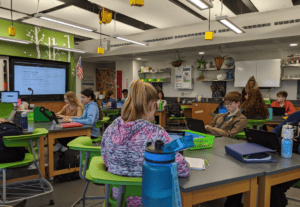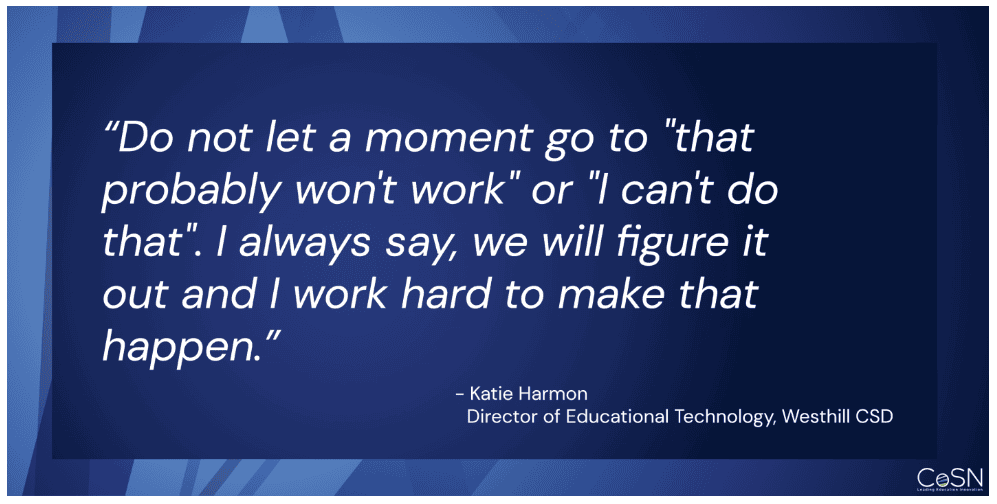For Katie Harmon, Director of Educational Technology at Westhill CSD and CoSN EdTech Innovation Committee Member, the vision for the district’s classrooms is for teachers to increase the amount of time they are facilitating students involved in exploration, inquiry, critical thinking, and collaboration, and to decrease the amount of time they spend lecturing.
Discover the steps that her district is taking to make that vision a reality.
Action: What steps did you or your school/district take to make progress in this area?
[Rich Digital Ecosystem]
We gave every teacher a Chromebook that is convertible and has a stylus. We also gave each student in grades 4-12 a similar Chromebook. We did a ton of training on Google Workspace, Kami, Peardeck, GoGuardian, Padlet, EdPuzzle, and more. We provided teachers with the tools they needed to change the way they teach and engage students. We also installed Chromecasts in every classroom to give teachers the freedom to teach from anywhere in the room, giving them breath to facilitate versus “sit-and-get” instruction.
[Changing Attitudes Toward Demonstrating Learning]
We have done professional development around EduProtocols and recently did a book study on Grading for Equity by Joe Feldman. We will be looking at how we can align our formative assessments to a guaranteed and viable curriculum, vertical alignment, how we are assessing student learning, and what we are asking students to do to demonstrate learning. We are also using iReady and data dashboards to have meaningful conversations about student (and teacher!) learning and growth.
 [Learner Agency]
[Learner Agency]
When it comes to the strategic planning process, our goals involve students becoming an integral part of our decision making.
Katie noted that her district is leveraging the Tech Enabler “Rich Digital Ecosystems” and the Accelerators “Changing Attitudes Toward Demonstrating Learning” and “Learner Agency.” Read more about these topics in the free 2024 Driving K-12 Innovation report.
Impact: What was the result? Who benefited? How will you move forward?
Though we have a lot of work to do, these ideas are growing and changing teachers’ perspectives of students and knowledge. Students are benefiting from the different types of lessons that teachers are providing that go beyond sit-and-get [instruction]. We are seeing more students involved and that is supported by the data.
Advice: Is there any advice you’d offer to others dealing with a similar challenge?
Consider digital tools and devices that align with your vision. Start with a pilot and support teachers with everything they need to make it work consistently and constantly. Do not let a moment go to “that probably won’t work” or “I can’t do that”. I always say, we will figure it out, and I work hard to make that happen. We have math teachers on board with Chromebooks — that’s rare from what I have seen and heard! Teacher support is one of my most important jobs.
Thank you for sharing your story, Katie!

About the EdTech Trail Mix Series
EdTech Trail Mix, is a collection of shared, bite-sized stories from the EdTech Innovation Committee and CoSN Members to help others drive impact. How are you using the Driving K-12 Innovation Report to improve systems in your schools? Share your EdTech Trail Mix today!
Additional Resources
Driving K-12 Innovation: 2024 Hurdles, Accelerators, & Tech Enablers
———
AUTHOR: Stephanie King, Writer and Communications Manager, CoSN’s EdTech Innovations Committee and Driving K-12 Innovation
Published on: April 3, 2024
CoSN is vendor neutral and does not endorse products or services. Any mention of a specific solution is for contextual purposes.


